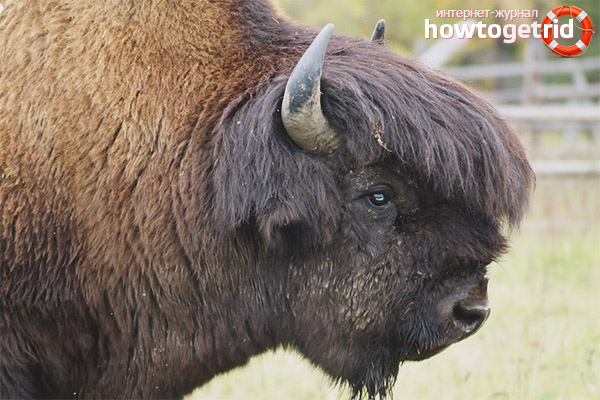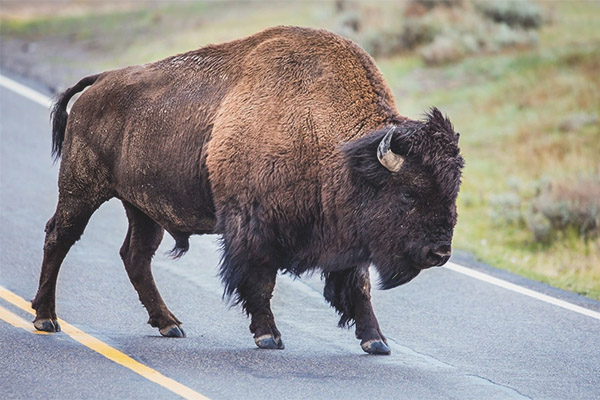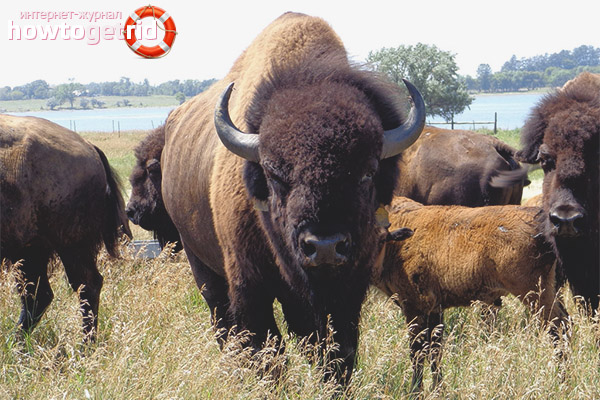The content of the article
Bison (Bisonbison) is a mammal that belongs to the horned family. This animal is one of the largest inhabiting the territory of North America.
On the verge of death
By the time colonizers settled in North America, the number of buffalo on this continent was about 60 million. Individual herds consisted of up to 20-30 thousand animals. The indigenous people of these lands - Indians - hunted buffaloes solely for the purpose of satisfying basic needs:
- for food;
- making clothes;
- providing the tribe with weapons that served as horns and bones;
- The skin of a buffalo was used to shelter a dwelling.
It can not be said that the livelihood of the Indians strongly influenced the number of these untidy. But with the arrival of the immigrants from Europe to the mainland, a rapid and sharp decline in the bison population in North America begins.Their killing was turned into a fun by the colonialists, and with the trade and industrial revolution that began in Europe, the extermination of animals was put on stream. Both the white hunters and the Indians were engaged in the destruction, and in return they were promised firearms, whiskey, knives, gunpowder. In those times, the skin of bison and their meat was in demand. The main reason for the massacre was the desire to deprive the indigenous population of the basis of existence, and, as a result, bring the Indians to starvation.
As a result of the bloody atrocities, by the beginning of the 20th century there were about 800 animals in the territory of the New World. In 1907, the government made the first attempts to rescue the endangered species: reserves and national parks were created, laws were passed prohibiting unauthorized shooting. These measures have allowed to increase the number to several tens of thousands of heads.
Bison subspecies
- forest;
- steppe.
Forest bison are larger than the steppe relatives. A distinctive feature of the steppe is the presence of the throat, located directly under the chin.In forest bison, this body has not reached its final development.
Habitats
The habitat of these hoofed mammals is strictly defined by the boundaries of National Parks. They now live in Canada and the northern borders of the United States.
There are no buffaloes in the wild in Russia. In 2006, the authorities of Canada donated 30 individuals of wood bison to the Ust-Buotama kennel (the Sakha Republic) - this species is listed in the Red Book. The plans of the nursery revival of the population of wood bison in the territory of the Russian Federation.
Appearance

Bison are among the largest mammals in North America. The body has a massive structure and reaches a length of 3 meters. Characteristic of the animal are broad shoulders and low hips. Height at withers - up to 2 meters due to a hump, the length of the vertebrae in which 30-33 cm. Legs are low, but strong and dense due to the large number of muscles. Adult males reach more than a ton. Females are more modest - 700-800 kg.
The animal has a powerful wide forehead, short hollow horns, a low-set head with small black barely noticeable eyes. The body of the animal is covered with thick dark dark brown wool.On the head, shoulders and chest hair is longer, on the chin like a beard. The hair on the front of the body grows to 50 cm. The pile on the back is shorter.
Wool has a brown color, sometimes brown. There are individuals of black-brown color. Cubs are born light brown or red, then the color of the pile darkens, the coat is made more rigid.
Habits and lifestyle
Bison live in herds that number several thousand animals. The top of the hierarchy belongs to several large males, constantly defending their leading position in the course of numerous fights. Females with calves and other males often form separate herds.
Bison have well developed eyesight and smell. They are able to sense a stranger located several kilometers away. The buffaloes, on the whole, are calm animals, but, sensing the danger, quickly turn into an aggressive offensive. When attacking a herd of wolves or coyotes, adults protect the young, driving away predators with their powerful horns and hooves. As a rule, wolves attack calves, trying to take them away from females and relatives.In the summer months, strong and well-fed animals give a fitting rebuff to the attackers. Despite their impressive size, the buffalo are agile and fast. They are able, if necessary, to gallop, developing a speed of 50 km / h, i.e. equal to the speed of the horse, and to overcome vertical obstacles with a height of more than 1.5 m. In winter, the buffalo are weakened by the lack of food, low temperatures, snow loads, which make it difficult to wade. This gives predators many opportunities for a successful outcome of the attack.
Huge animals are great swim. This ability is necessary for them to move to new pastures. In the summer, they easily cross rivers. In the winter and, especially, in the spring, the transition through frozen rivers is fraught with great danger. Ice in some areas can not withstand the weight of the animal. A beast caught in icy water is doomed to death.
What do bison eat
Bison - herbivores. During summer abundance, their diet consists of grassy meadow grasses, some species eat leaves of trees, branches of bushes and young shoots. In winter, they feed on moss and lichen. They find food under snowdrifts up to 1 meter deep, with the help of their massive muzzle, digging up snow.
In the summer, animals are gaining weight. The daily rate of vegetation consumed is 23-25 kg. Food enters one of the chambers of the stomach, where cellulose is broken down by the action of enzymes. Then they regurgitate the mash, and then chew again. The food then passes through three other sections of the stomach, where the digestive process continues, and enters the intestine.
Reproduction and education of offspring
From May to September, the rut period begins at the bison. This is a hot time for males, in the herd the bloody battles for the location of the female do not stop. Skirmishes sometimes end in deadly wounds. Wedding fights are always accompanied by a low thick roar, which can be heard at a distance of 8 km in calm weather. During the breeding season, the flock disintegrates. Females with yearling calves and males graze separately. In the autumn after the end of the “weddings” period, the herd reunites.
The dominant males will fertilize several females, collecting harems, but the choice of a decent one is the same for the female. Having won the battle, the bull does not always have to taste, and the female runs away from him. The bulls can walk for about a week for the female in water until it “melts”.After intercourse, the duration of which does not exceed 20 seconds, the bull is next to the female for some time, then goes in search of a new passion.
The first few months, the calf feeds on mother's milk and quickly gains weight, gaining a weight of 300 kg by the year. Juveniles are always under the supervision of adults, because playful and careless calves are easy prey for predators. Another danger to the cubs is the harsh winter.Not having had time to get stronger and gain enough fat, individuals do not survive in severe frosts. According to statistics provided by employees of Yellowstone National Park, half of the young in the herd do not live to the age of one year.
Bison reach sexual maturity at 4 years. Males are especially vulnerable at this time - they still cannot compete with older and more powerful individuals, and often receive serious injuries in fights. In the wild, animal life expectancy is on average 20 years. In captivity, some individuals live to 25 years.
Video: Bison (Bison bison)












To send